10 Fast-Growing Flowering Vines You Should Grow to Add Color on a Trellis
From winter-hardy to tropical, here are vines for every growing zone
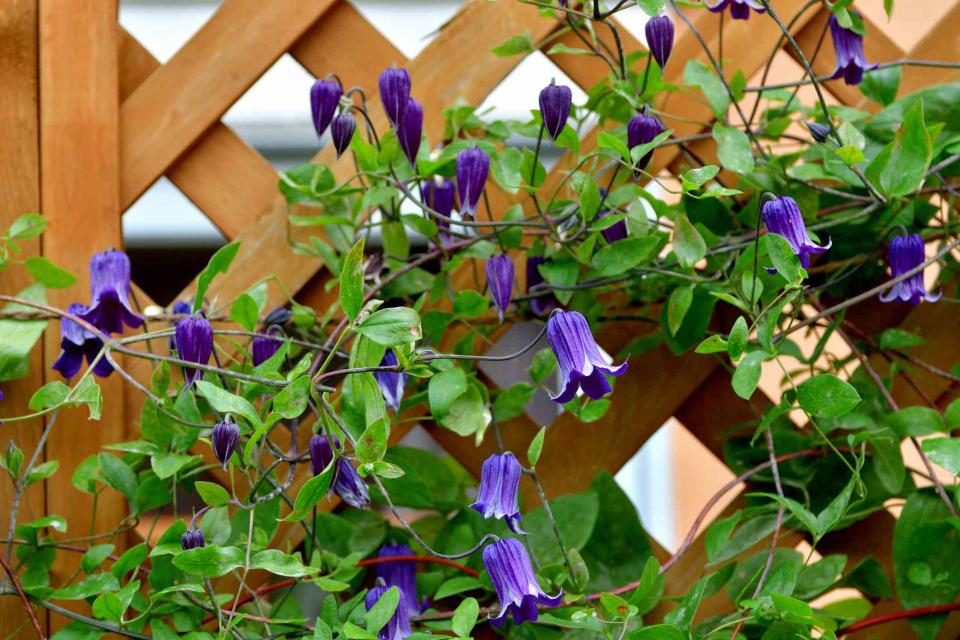
Getty Images
It can be tricky to find a fast-growing vine to cover the arbor you just built, to disguise an unsightly wall or fence, or to create more privacy in your yard.
There are many perennials and annual vines available but what you most want from a vine—fast growth and prolific bloom—often backfires because many of the vines that fit that bill are invasive, either by self-sowing or spreading via suckers (morning glory being one of the most notorious self-seeders).
Here are ten fast-growing vines with beautiful flowers suitable for a wide range of growing zones.
Honeysuckle
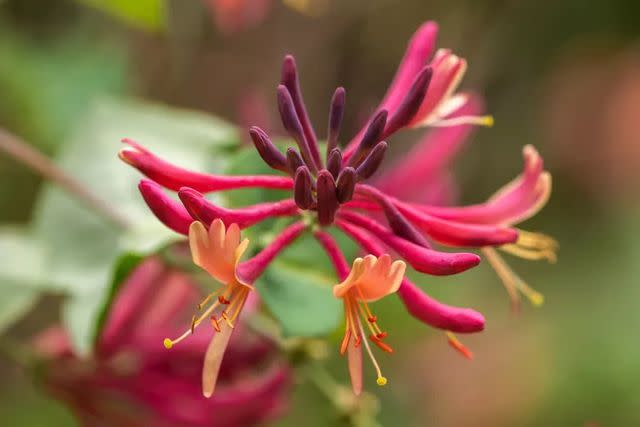
The Spruce / Evgeniya Vlasova
The Lonicera genus includes several twining vines which are valued for their showy, fragrant, tubular blooms and oval-shaped shiny leaves. In warmer climates, many varieties are evergreen. The flowers attract hummingbirds, butterflies, bees, and other pollinators.
The size and hardiness of the vine varies. The hybrid Goldflame honeysuckle (Zone 5-9) grows 10 to 15 feet tall. Coral honeysuckle (Zone 4-11), which is native to North America, grows 15 to 25 feet tall and wide but can be pruned to a desired shape or size.
Name: Honeysuckle (Lonicera spp.)
USDA Hardiness Zones: 4-11 depending on species
Bloom Season: Spring, summer
Light: Full sun to partial shade
Soil: Well-drained
Wisteria
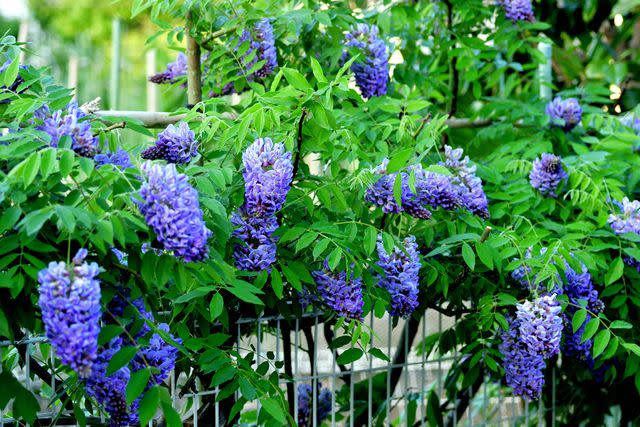
magicflute002 / Getty Images
As popular as it is for its unmistakable bluish or purplish, fragrant racemes in the spring, wisteria has a caveat: The most commonly planted varieties, Japanese and Chinese wisteria, are invasive in North America. That does not mean, however, that you should shy away from wisteria altogether.
Plant an American wisteria (Wisteria frutescens), which eventually grows up to 30 feet tall but is still smaller and not as massive as the Asian species and not an aggressive spreader.
Name: Wisteria (Wisteria spp.)
USDA Hardiness Zones: 5=9
Bloom Season: Spring
Light: Full sun to partial shade
Soil: Well-drained
Toxicity: Toxic to humans and pets
Bougainvillea
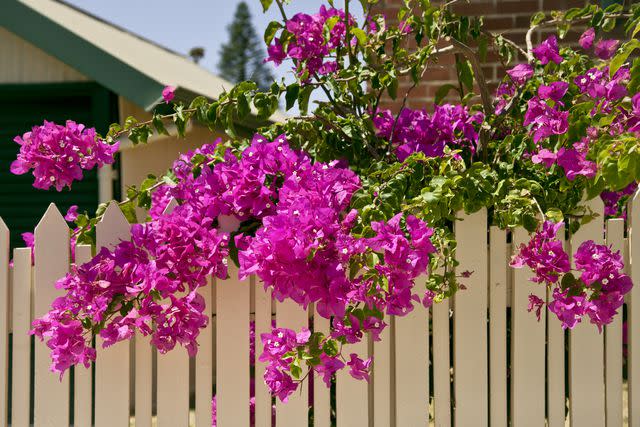
Jenny Dettrick / Getty Images
This vigorous, thorny vine grows in sunny, dry climates. It is native to South America but widely found in the Mediterranean. Growing 15 to 40 feet tall and wide, the vine needs a sturdy support, such as a wall.
The actual flowers are small, what is perceived as flowers are colorful papery bracts in white, pink, purple, red, and yellow around each cluster of flowers.
Name: Bougainvillea (Bougainvillea spp.)
USDA Hardiness Zones: 9-11
Bloom Season: Seasonal bloomer
Light: Full sun
Soil: Well-drained
Climbing Hydrangea
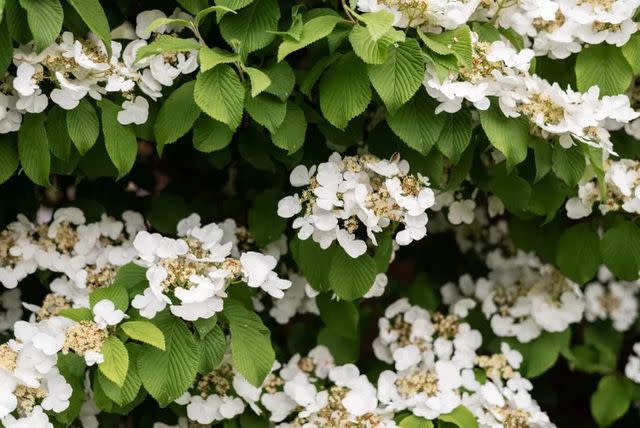
The Spruce / Loren Probish
The attribute of fast-growing does not apply to the climbing hydrangea at the beginning—the vine starts very slowly and may take up to three to five years to reach the flowering stage. But once established, it reaches a height of 50 feet or more at maturity and produces fragrant, white lacy blooms all summer long.
Name: Climbing hydrangea (Hydrangea anomala)
USDA Hardiness Zones: 4-8
Bloom Season: Spring, summer
Light: Full sun to partial shade
Soil: Moist, well-drained
Toxicity: Toxic to humans and pets
Clematis
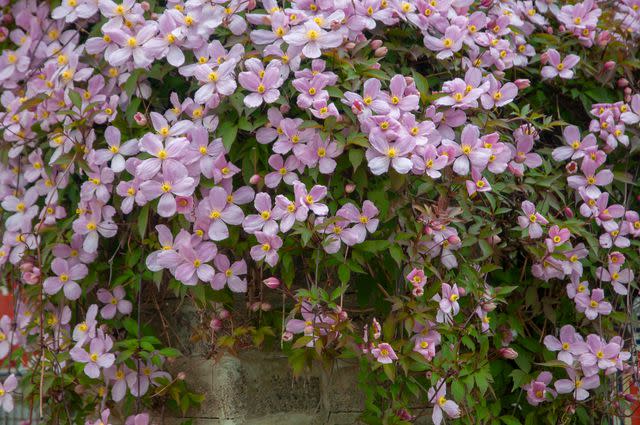
The Spruce / Evgeniya Vlasova
'Apple blossom' clematisThere are hundreds of clematis species and thousands of cultivars blooming between late winter and the first fall frost with large, white, blue, violet, purple, pink, red, or bicolor flowers.
If you want to introduce more native plants to your landscape, select a native clematis species such as the white-flowering virgin’s bower (C. virginiana) or the purple clematis (Clematis occidentalis var. occidentalis).
Name: Clematis (Clematis spp.)
USDA Hardiness Zones: 4-9
Bloom Season: Spring, summer, fall
Light: Full sun
Soil: Loamy, well-drained
Toxicity: Toxic to humans and pets
Purple Passionflower
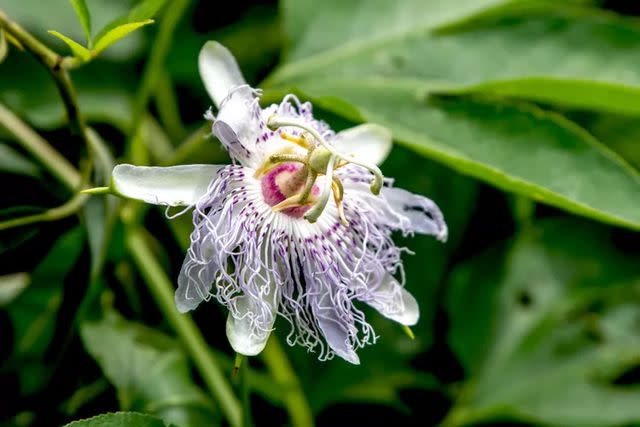
The Spruce / Adrienne Legault
Native to North America, purple passionflower is the hardiest of the passionflower species. The tendril-climbing vine grows 20 feet tall. Its flowers, which attract pollinators, appear between midsummer and early fall but each lasts only for about one day.
Name: Purple passionflower (Passiflora incarnata)
USDA Hardiness Zones: 7-11
Bloom Season: Summer, fall
Light: Full sun to partial shade
Soil: Well-drained
Trumpet Creeper
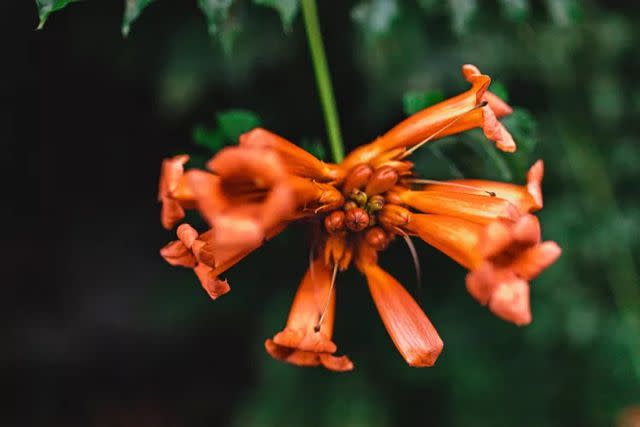
The Spruce / Autumn Wood
Because of its aggressive growth, gardeners are often reluctant to plant the native trumpet creeper whose trumpet-shaped, orange flowers are beloved by pollinators. Varieties that are reportedly less invasive include ‘Apricot’ and ‘Indian Summer.'
To keep its prolific suckering under control, plant it near concrete or an area that is regularly mowed. Make sure to have a sturdy structure in place for the 30- to 40-foot vine.
Name: Trumpet vine (Campsis radicans)
USDA Hardiness Zones: 4-10
Bloom Season: Summer
Light: Full sun to partial shade
Soil: Moist but well-drained
Toxicity: Toxic to humans
Carolina Jessamine
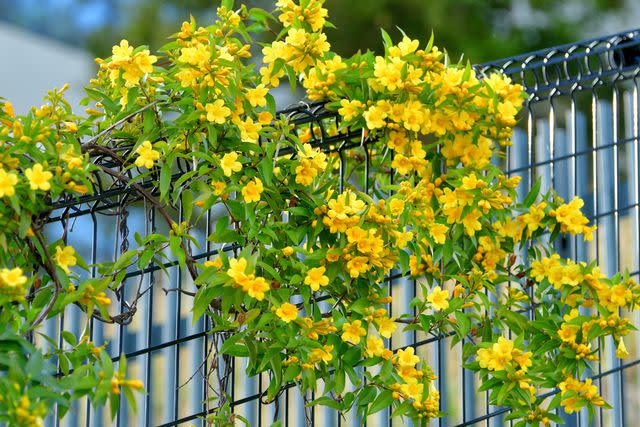
Photos from Japan, Asia and othe of the world / Getty Images
Between February and April, the vine with shiny evergreen leaves is covered with trumpet-shaded, fragrant, yellow flowers. The 10- to 20-foot-tall vines climb up a trellis and gracefully cascade down and blow in the wind. Carolina jessamine is native to the South and also grown as a groundcover.
Name: Carolina jessamine (Gelsemium sempervirens)
USDA Hardiness Zones: 6-9
Bloom Season: Spring
Light: Full sun to partial shade
Soil: Moist but well-drained
Mandevilla
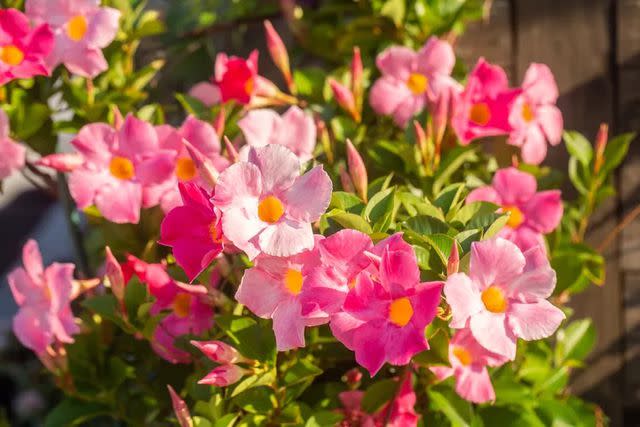
The Spruce / Phoebe Cheong
These tropical flowering vines have trumpet-shaped flowers in shades of pink, red, and white, occasionally with yellow throats. Its mature size is 3 to 10 feet tall and 3 to 4 feet wide. The summer bloom may stretch into fall, though in warm climates they can bloom year-round. Some species within the genus have smaller, more plentiful blooms while others have fewer, larger blooms.
Name: Mandevilla (Mandevilla spp.)
USDA Hardiness Zones: 10-11
Bloom Season: Summer, fall
Light: Full sun to partial shade
Soil: Sandy, moist but well-drained
Climbing Rose
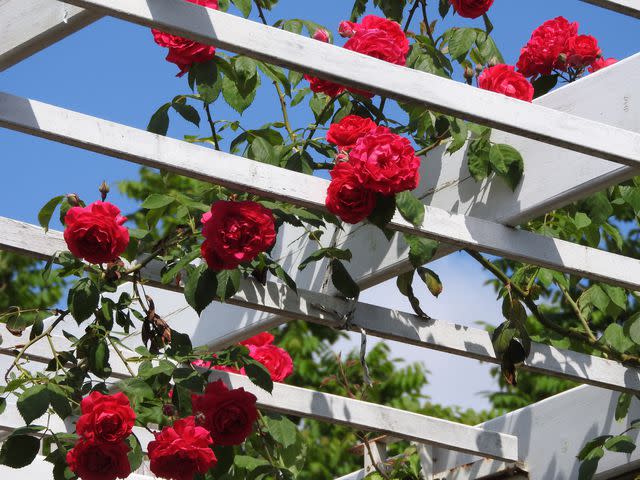
M. Long / Getty Images
Climbing roses are very tall roses with extra-long canes that are secured to a trellis or other support structure. The care for climbing roses is similar to those of other types of hybrid roses, and the choices are just as numerous—some climbing roses, such as the popular ‘Cécile Brunner’, grow up to 20 feet tall. They also vary in their hardiness so make sure to pick a variety that fits your climate.
Name: Climbing rose (Rosa spp.)
USDA Hardiness Zones: 4-11 depending on the variety
Bloom Season: Spring, summer, fall
Light: Full sun
Soil: Moist, well-drained
Frequently Asked Questions
What is the fastest-growing vine?
One of the fastest-growing vines is the chocolate vine, a perennial vine native to Asia. It adds as much as 40 feet in one growing season.
What is a fast-growing vine to cover a fence?
To disguise a fence, annual vines do the job the fastest. Consider ornamental beans such as hyacinth beans or black-eyed Susan vine. If you are less pressed for time, there are plenty of perennial vines to choose from.
What is a fast-growing vine for shade?
Virginia creeper is a native vine that does well in partial shade and shade. It grows on stone walls and trellises, supported by its grasping tendrils. In the fall, the foliage changes to a spectacular reddish-orange to burgundy.
Read the original article on The Spruce.

